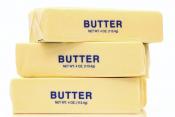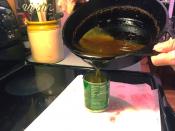Address
P.O. Box 72 | 2 N Ash St. | Omak, WA 98841
Phone
509-826-1170

FOG refers to fats, oils and grease, which are the natural by-products of food preparation and cooking or baking.
While they may add extra flavor to your food, if they are poured down the drain, they can leave a real mess in the sewer collection system by forming clogs and blockages that lead to overflows.
The collection system is a network of pipes and pump stations that moves wastewater from homes and businesses to the City’s wastewater treatment plant. From your sink or toilet, waste moves through your plumbing to a Sewer Lateral Line that runs from your house to the Sewer Lines in the City. Once in the Sewer lines it might have to go through Lift Stations or Pumps to make its way to the Treatment Plant.
FOG seems harmless when it is a warm liquid because it goes down the drain so easily. But once it cools off, it sticks to sewer pipes and builds up over time. Plus, whatever you put down the drain or garbage disposal, such as coffee grounds or eggshells, or toss in the toilet (besides toilet paper) – hair, dental floss, cigarette butts, candy wrappers, toys, kitty litter, ANYTHING – gets tangled up in that FOG. This blocks the flow of wastewater through the pipe forcing it back up the drain resulting in flooding of a home, a street, or a stream with wastewater.
Yes! If every person in Omak poured just one tablespoon of FOG down the drain, it would be the equivalent of dumping over 19 Gallons of FOG into the sewer. Every little bit adds up to create big clogs that cause spills and overflows. In fact, in the past three years, 90% of FOG-related overflows happened on residential lines.
FOG does not mix with water, and detergents used to “wash it down the drain” typically separate from the FOG after a period of time, which means that it ends up clinging to the pipes, restricting the flow of wastewater. The garbage disposal just chops up the bits of food you put into it, basically moving the problem downstream. The bottom line is that using soap or the disposal is not the solution to reducing FOG.
Yes! If you are connected to Omak's collection system, then you have a vested interest in the reliability and life span of the system and treatment plant. Even if you never experience a FOG-related overflow, the rates you pay on your monthly Utility bill fund the maintenance, repair, and replacement of the system. Plus, if there is a spill that gets into a waterway, the City could be fined and have to pay other clean up costs as well. There is also the potential for ecological damage to the City and County’s waterways that contribute to the quality of life for all residents.

Some common culprits are food scraps, meat trimmings, poultry skin, the “skim” from soups and gravies, cooking oils, lard and shortening, salad dressings, sauces and marinades, dairy products (including ice cream), and butter or margarine. Also, if you use your garbage disposal to dump coffee grounds, eggshells, or other items down the drain this will accelerate FOG-related clogs since it provides extra surfaces for everything to stick to.
FOG can come from a variety of sources, many of which we forget contain FOG. Examples include:

Yes. FOG is a concern to you, because it may cause clogging of the lateral line that goes to your septic tank or other on-site treatment system. Avoiding disposal of FOG down your drain is a good practice regardless of the system you are on.

Being a part of the solution is as easy as following some standard practices around the kitchen, such as:
Other ways to be a part of the FOG solution include reporting any illegal dumping or spills immediately. You can also help by educating your neighbors and others in your community. IF you see someone pouring their FOG down the drain, let them know the harm it can cause or just send them here to learn more!